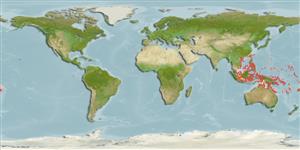Common names from other countries
>
Ovalentaria/misc (Various families in series Ovalentaria) >
Pomacentridae (Damselfishes) > Pomacentrinae
Etymology: Neopomacentrus: Greek, neos = new + Greek,poma = cover, operculum + Greek,kentron = sting (Ref. 45335).
More on author: Bleeker.
Environment: milieu / climate zone / depth range / distribution range
Ecologie
marien rifbewoner; standvastig; diepte 1 - 30 m (Ref. 1602). Tropical; 25°N - 21°S
Western Central Pacific: Indonesia to Solomon Islands, north to Japan, south to northern Australia and Vanuatu.
Grootte / Gewicht / Leeftijd
Maturity: Lm ? range ? - ? cm
Max length : 7.5 cm TL mannelijk / geslacht onbekend; (Ref. 48636)
Korte beschrijving
Morfologie | Morfometrie
Dorsale stekels (totaal): 13; Dorsale zachte stralen (totaal): 11-12; Anale stekels 2; Anale zachte stralen: 10 - 11.
Adults are found in lagoons, harbors, and coastal reefs, shallow habitats, deep sand or mud slopes with outcrops of debris or coral rubble pieces, or on rocky substrates in sheltered bays. They usually occur in large aggregations, sometimes forming mixed aggregations with Neopomacentrus sp. Abundant around sponge-encrusted mooring buoys and their anchor lines and occur in smaller colonies around rocks and refuse (Ref. 1602). Oviparous, distinct pairing during breeding (Ref. 205). Eggs are demersal and adhere to the substrate (Ref. 205). Males guard and aerate the eggs (Ref. 205). Diurnal species (Ref. 113699).
Levenscyclus en paargedrag
Maturiteit | Voortplanting | Paaien | Eieren | Fecunditeit | Larven
Oviparous, distinct pairing during breeding (Ref. 205). Eggs are demersal and adhere to the substrate (Ref. 205). Males guard and aerate the eggs (Ref. 205).
Allen, G.R., 1991. Damselfishes of the world. Mergus Publishers, Melle, Germany. 271 p. (Ref. 7247)
Status op de Rode Lijst van het IUCN (Ref. 130435)
CITES (Ref. 128078)
Not Evaluated
Gevaar voor de mens
Harmless
Gebruik door de mens
Meer informatie
ReferentiesAquacultuurAquacultuurprofielKweeklijnenGeneticaElectrophoresesErfelijkheidZiektesVerwerkingMassaconversie
Tools
Speciale rapporten
Download XML
Internetbronnen
Estimates based on models
Preferred temperature (Ref.
115969): 26.1 - 29.3, mean 28.7 (based on 1965 cells).
Fylogenetische diversiteitsindex (Ref.
82804): PD
50 = 0.5000 [Uniqueness, from 0.5 = low to 2.0 = high].
Bayesian length-weight: a=0.01514 (0.00687 - 0.03334), b=2.99 (2.80 - 3.18), in cm Total Length, based on LWR estimates for this species & (Sub)family-body (Ref.
93245).
Trofisch niveau (Ref.
69278): 3.4 ±0.45 se; based on food items.
Weerstandsvermogen (Ref.
120179): Hoog, minimale populatieverdubbelingstijd minder dan 15 maanden (Preliminary K or Fecundity.).
Fishing Vulnerability (Ref.
59153): Low vulnerability (10 of 100).
